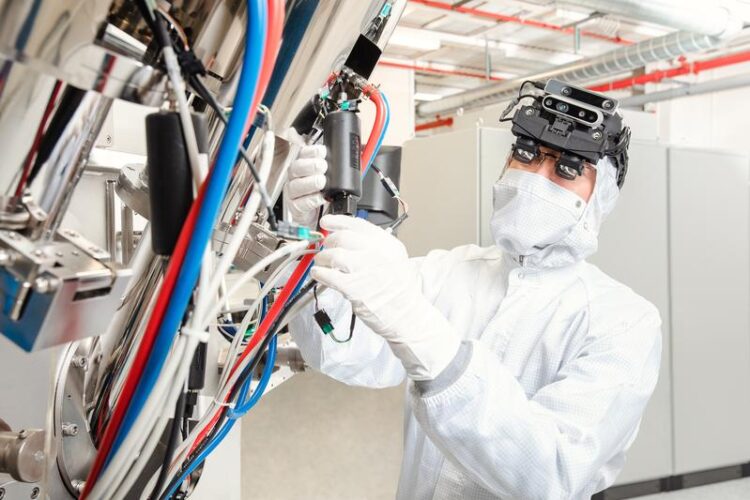secureAR – Modular AR service platform for industrial production

Novel AR assistance system for industrial use
© Fraunhofer FEP, Photographer: Claudia Jacquemin; Picture in printable resolution: www.fep.fraunhofer.de/press
Within the project secureAR (funded by the Federal Ministry of Education and Research), a cross-industry and open cloud-based service platform with open industry interfaces is being developed. Within secureAR, the Fraunhofer Institute for Organic Electronics, Electron Beam and Plasma Technology FEP is researching a novel hardware platform that is used in an innovative AR assistance system for the location- and situation-specific provision and visualization of data in different industrial scenarios.
This hardware platform will be presented at electronica 2022, from November 15 to 18, 2022, in Munich/Germany, at the Fraunhofer joint booth B4.258, in Hall B4.
In the future, factories will have to produce individual products even more flexibly than today and achieve greater profitability – in a short time, at low cost, with the highest quality. The employees are supported in the best possible way by modern AR (augmented reality) assistance systems and integrated into the production and service processes. This enables an improvement of working conditions as well as production processes- and also opens up completely new business models and services.
The aim of the secureAR joint project is to investigate innovative services in the industrial production environment. For this purpose, a cross-industry and open-cloud based service platform collects data along the entire value chain, from planning to production processes to plant maintenance, and enables location- and situation-specific provision and visualization of the data by a new type of AR assistance system. Within the project, it is initially optimized for use in electronics manufacturing and for aircraft construction.
Bernd Richter, Head of the department for Organic Microelectronic Devices at Fraunhofer FEP and head of the subproject for the research of the hardware components, describes the system: “Previous AR systems are primarily designed for the consumer market. Due to the modular design of the new AR assistance system of secureAR, it is easy to adapt to all industrial scenarios. We have placed particular emphasis on ergonomics and compliance with the requirements of industrial production. For example, the system can be easily combined with personal protective equipment, such as a bumper cap.”
The system is equipped with cameras that detect the position of the wearer in the room, but it also detects objects in the near field. In this way, operating instructions or information from other persons who are not on site – e.g. remote maintenance – can be displayed in a targeted manner. Ergonomics have been improved and the strain on the wearer in the industrial environment has been significantly reduced. The system is expandable with additional sensors and interfaces.
The data is always acquired and transmitted on a sensor basis. In the industrial environment, such data must be specially protected as business secrets. Currently available AR devices, such as mobile phones, tablets or even data glasses, are permanently connected to the Internet and cannot provide such protection because they are directly connected to the common cloud systems of their providers. The modular open source operating system L4Re is used on the novel assistance system for secure data acquisition. While consistently respecting data, property and privacy rights, the data is transferred directly to the open cloud-based service platform developed by secureAR. Thus, the joint project makes an important contribution to Germany’s and Europe’s digital sovereignty.
The use of tiny OLED microdisplays that consume little power has resulted in a lightweight, ergonomic system that can be used both binocular and monocular. The Fraunhofer FEP is specialized in the research and production of customized and project-specific microdisplays and their integration into complex systems. For this purpose, the institute can draw on many years of experience in the realization of a wide variety of microdisplay architectures.
About the project “secureAR”
Secure AR service platform for industrial production
Funded by the Federal Ministry of Education and Research
Funding reference: 02K18D014
Duration 01.05.2020 – 30.02.2023
www.fep.fraunhofer.de/secure-ar
Partners
Siemens AG, project coordinator
Airbus Operations
GESTALT Robotics
Kernkonzept GmbH
Technische Universität Dresden, Fakultät Informatik
Bundesanstalt für Arbeitsschutz und Arbeitsmedizin
Fraunhofer FEP
Fraunhofer FEP at electronica 2022
15. – 18. November 2022
Munich trade fair, Munich, Germany
Fraunhofer joint booth no. B4.258, hall B4
Originalpublikation:
Media Contact
All latest news from the category: Power and Electrical Engineering
This topic covers issues related to energy generation, conversion, transportation and consumption and how the industry is addressing the challenge of energy efficiency in general.
innovations-report provides in-depth and informative reports and articles on subjects ranging from wind energy, fuel cell technology, solar energy, geothermal energy, petroleum, gas, nuclear engineering, alternative energy and energy efficiency to fusion, hydrogen and superconductor technologies.
Newest articles

NASA: Mystery of life’s handedness deepens
The mystery of why life uses molecules with specific orientations has deepened with a NASA-funded discovery that RNA — a key molecule thought to have potentially held the instructions for…

What are the effects of historic lithium mining on water quality?
Study reveals low levels of common contaminants but high levels of other elements in waters associated with an abandoned lithium mine. Lithium ore and mining waste from a historic lithium…

Quantum-inspired design boosts efficiency of heat-to-electricity conversion
Rice engineers take unconventional route to improving thermophotovoltaic systems. Researchers at Rice University have found a new way to improve a key element of thermophotovoltaic (TPV) systems, which convert heat…



